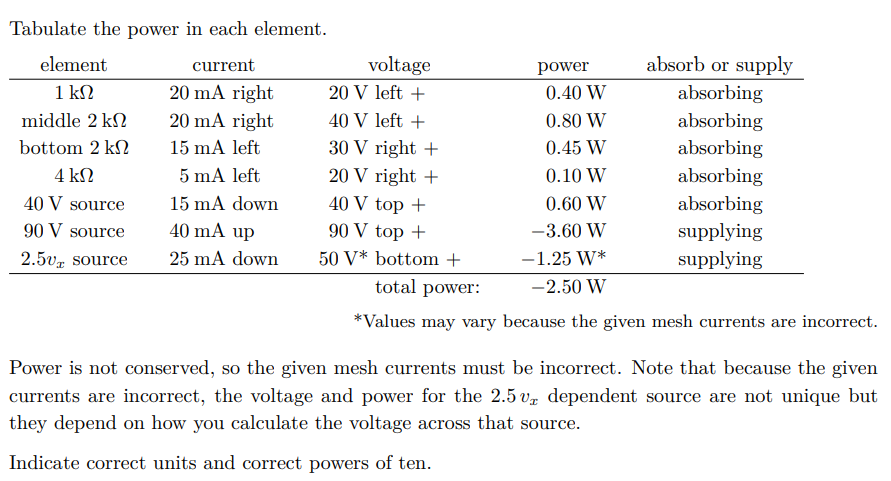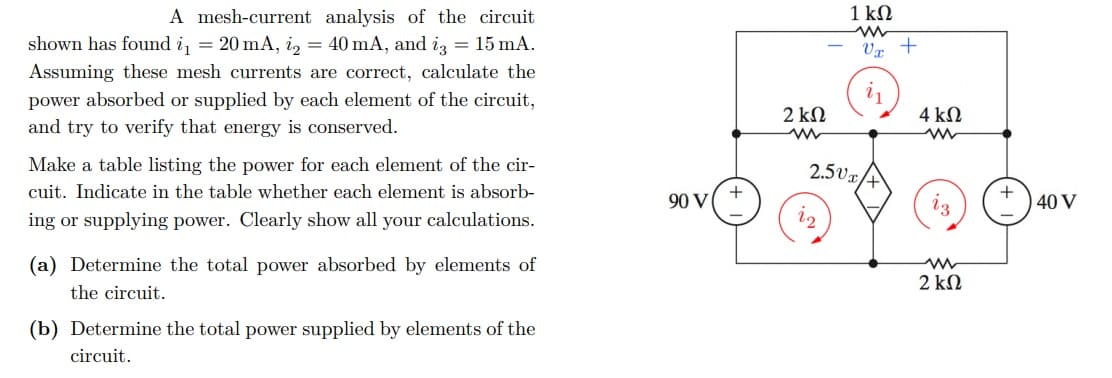Make a table listing the power for each element of the cir- cuit. Indicate in the table whether each element is absorb- ing or supplying power. Clearly show all your calculations. (a) Determine the total power absorbed by elements of the circuit. (b) Determine the total power supplied by elements of the circuit.
Make a table listing the power for each element of the cir- cuit. Indicate in the table whether each element is absorb- ing or supplying power. Clearly show all your calculations. (a) Determine the total power absorbed by elements of the circuit. (b) Determine the total power supplied by elements of the circuit.
Introductory Circuit Analysis (13th Edition)
13th Edition
ISBN:9780133923605
Author:Robert L. Boylestad
Publisher:Robert L. Boylestad
Chapter1: Introduction
Section: Chapter Questions
Problem 1P: Visit your local library (at school or home) and describe the extent to which it provides literature...
Related questions
Question
The instructions are on the pictures with all the info.
Use the method of mesh-current analysis to determine the correct mesh currents
Show all your calculations. Then, make a neat table listing the current, voltage, and power for each element of the circuit, and indicate whether each element is absorbing or supplying power. Verify that power is conserved.

Transcribed Image Text:Tabulate the power in each element.
element
current
voltage
absorb or supply
power
1 kN
20 mA right
20 V left +
0.40 W
absorbing
middle 2 kN
20 mA right
40 V left +
0.80 W
absorbing
absorbing
30 V right +
20 V right +
bottom 2 k2
15 mA left
0.45 W
4 kN
5 mA left
0.10 W
absorbing
absorbing
supplying
15 mA down
40 V top +
90 V top +
40 V source
0.60 W
90 V source
40 mA up
-3.60 W
2.5v source
25 mA down
50 V* bottom +
-1.25 W*
supplying
total power:
-2.50 W
*Values may vary because the given mesh currents are incorrect.
Power is not conserved, so the given mesh currents must be incorrect. Note that because the given
currents are incorrect, the voltage and power for the 2.5 v, dependent source are not unique but
they depend on how you calculate the voltage across that source.
Indicate correct units and correct powers of ten.

Transcribed Image Text:A mesh-current analysis of the circuit
1 kN
shown has found i, = 20 mA, i, = 40 mA, and iz = 15 mA.
Vr +
Assuming these mesh currents are correct, calculate the
power absorbed or supplied by each element of the circuit,
and try to verify that energy is conserved.
i1
4 kN
2 kN
Make a table listing the power for each element of the cir-
2.5vx/
cuit. Indicate in the table whether each element is absorb-
90 V
13
40 V
ing or supplying power. Clearly show all your calculations.
(a) Determine the total power absorbed by elements of
2 kN
the circuit.
(b) Determine the total power supplied by elements of the
circuit.
Expert Solution
This question has been solved!
Explore an expertly crafted, step-by-step solution for a thorough understanding of key concepts.
Step by step
Solved in 4 steps with 1 images

Knowledge Booster
Learn more about
Need a deep-dive on the concept behind this application? Look no further. Learn more about this topic, electrical-engineering and related others by exploring similar questions and additional content below.Recommended textbooks for you

Introductory Circuit Analysis (13th Edition)
Electrical Engineering
ISBN:
9780133923605
Author:
Robert L. Boylestad
Publisher:
PEARSON

Delmar's Standard Textbook Of Electricity
Electrical Engineering
ISBN:
9781337900348
Author:
Stephen L. Herman
Publisher:
Cengage Learning

Programmable Logic Controllers
Electrical Engineering
ISBN:
9780073373843
Author:
Frank D. Petruzella
Publisher:
McGraw-Hill Education

Introductory Circuit Analysis (13th Edition)
Electrical Engineering
ISBN:
9780133923605
Author:
Robert L. Boylestad
Publisher:
PEARSON

Delmar's Standard Textbook Of Electricity
Electrical Engineering
ISBN:
9781337900348
Author:
Stephen L. Herman
Publisher:
Cengage Learning

Programmable Logic Controllers
Electrical Engineering
ISBN:
9780073373843
Author:
Frank D. Petruzella
Publisher:
McGraw-Hill Education

Fundamentals of Electric Circuits
Electrical Engineering
ISBN:
9780078028229
Author:
Charles K Alexander, Matthew Sadiku
Publisher:
McGraw-Hill Education

Electric Circuits. (11th Edition)
Electrical Engineering
ISBN:
9780134746968
Author:
James W. Nilsson, Susan Riedel
Publisher:
PEARSON

Engineering Electromagnetics
Electrical Engineering
ISBN:
9780078028151
Author:
Hayt, William H. (william Hart), Jr, BUCK, John A.
Publisher:
Mcgraw-hill Education,